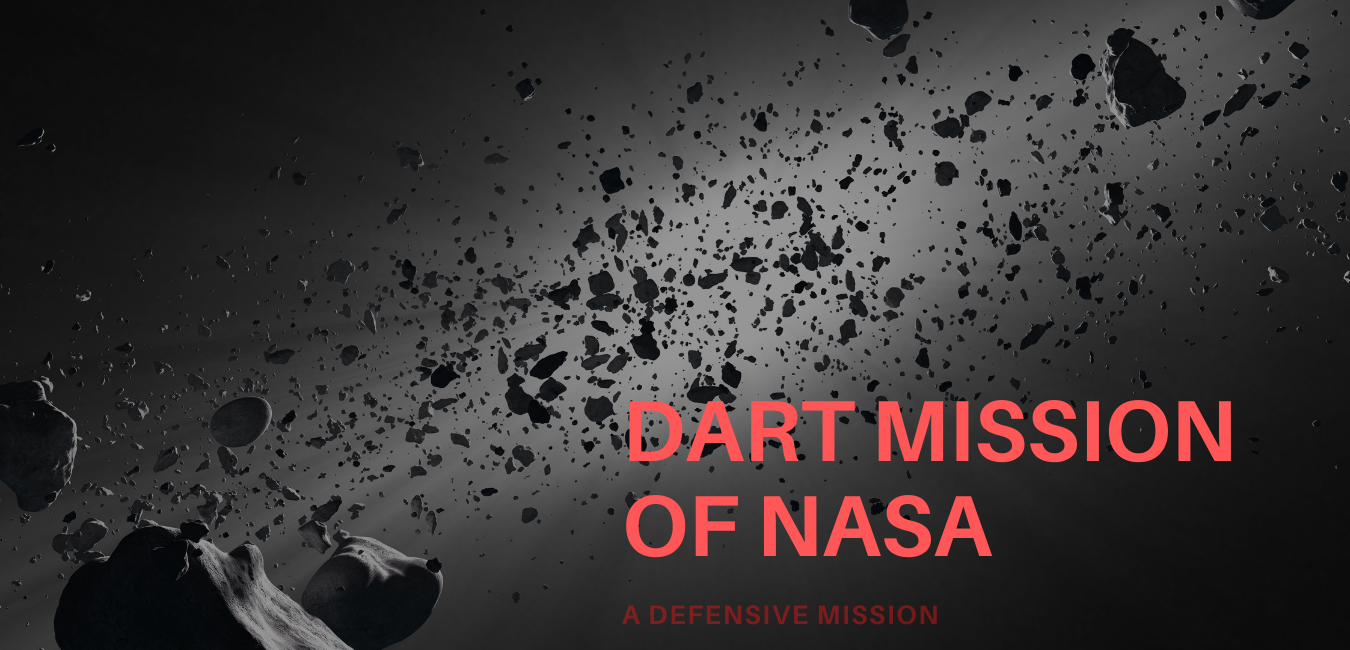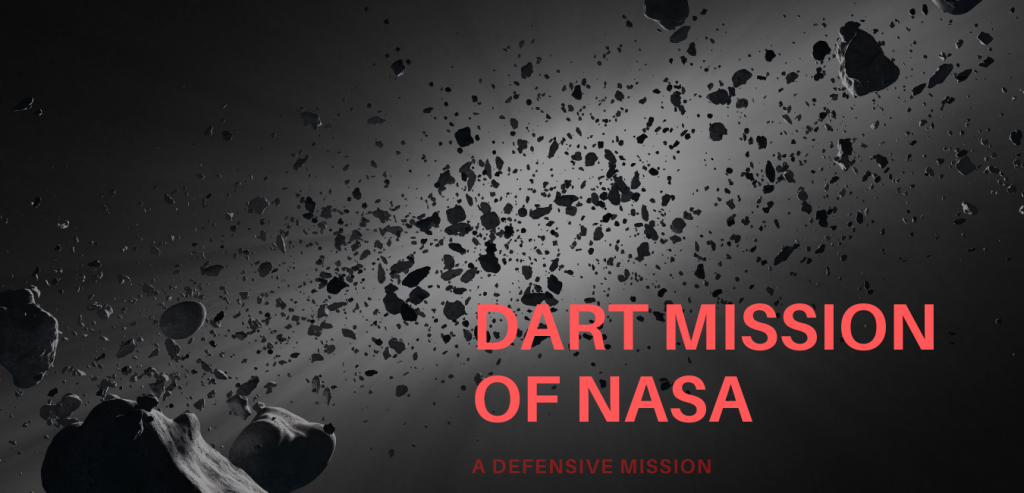

NASA worked on several projects for the humans safe living, and Double Asteroid Redirection Test (DART) mission of NASA is next project with new idea and more expectations. NASA’s primary focus is to detect the threat of Earth’s near objects as they could cause potential harm. To evaluate their technologies, NASA is conducting the DART mission to prevent a hazardous asteroid striking from the Earth.
NASA has chosen Dimorphos for this mission because of its size, which may threaten the Earth. The DART will deliberately crash into Dimorphos at a speed of 14,763.8 miles per hour. According to the European Space Agency, this will be the first mission, humans are altering the dynamics of a solar system in a measurable way.
Table of Contents
What is DART ?
DART mission of NASA is known as the Double Asteroid Redirection Test. The DART mission is NASA’s demonstration of kinetic impactor technology, impacting an asteroid to adjust its speed and path.
The DART spacecraft launch window begins from November 24, 2021, to February 15, 2022. DART may launch aboard a SpaceX Falcon 9 rocket from Vandenberg Air Force Base, California. Thus, the DART is a design made carefully for demonstration
How does DART work ?
The Didymos binary beings are intensely observing using telescopes on Earth to precisely measure its properties before DART arrives. A camera will be attached to DART, and its autonomous navigation software will help the spacecraft detect and collide with it. By utilizing electric propulsion, DART could benefit from significant flexibility to the mission timeline.
When the launch takes place in November, NASA will test its asteroid deflection technology in September 2022. The test will examine how they impact the motion of an Earth’s asteroid near space.
The DART Mission of NASA – Plan to execute
DART mission of NASA expects to demonstrate that a pre-programmed and unaided spacecraft could independently rendezvous or meet up with a non-maneuvering and cooperating satellite. A successful mission was developed and divided among four defined mission phases. The four mission phases were as follows:
1) The launch and early orbit phase,
2) The rendezvous phase,
3) The proximity operations phase,
4) The departure and retirement phase.
NASA planned to demonstrate that a comparison of position and velocity data from GPS receivers in two spacecraft would be accurate, enough to guide the chaser spacecraft (DART) to a position within the effective range.
DART was programmed to evaluate AVGS performance through a series of precise, close-range maneuvers when it was 1 kilometer behind MUBLCOM
The DART and Mublcom Spacecraft
DART presented as planned during the first eight hours through the launch. The early orbit, and rendezvous phases of the mission, accomplishing all objectives up to that time, even though ground operations personnel noticed anomalies with the navigation system. The Advanced Video Guidance Sensor (AVGS) mission’s primary sensor would collect navigation data while DART was near MUBLCOM.
The AVGS would gather data from laser signals reflected off-targets mounted on MUBLCOM. It uses the signals to calculate relative bearing and range data. Thus, the direction and distance from DART to MUBLCOM. Other navigational sensors that work in concert with the AVGS included two Global Positioning System (GPS) receivers on DART and a GPS receiver on MUBLCOM.
DART – Work of New Scientists
Dr.Bonnie Buratti, the jet propulsion laboratory, will use Earth’s telescopic observations of Didymos and Dimorphos to characterize the surface reflect and roughness of DART’s arrival. It also observes DART, which refines the knowledge in mapping the geological features of the asteroids.
Dr.Ludmilla Kolokolova will use sophisticated radiative transfer models to analyze and interpret images of plumes taken by LICIA cube’s cameras. The distribution has an understanding for the momentum enhancing the effect of DART’s kinetic impact.
Dr.Jay McMahon will apply the dynamical theory of interacting non-spherical bodies and radiative forces. It understands the changes in Dimorphos’s orbit caused by physical effects other than DART’s kinetic impact. It also helps to interpret the post-impact Earth’s observation.
Dr.Stephen Schwartz develops a new computational approach to link fluid-based simulations of impacts to particle-based simulations of the results. The connection observes the properties of the plume to the physical properties of Dimorphos’s surface
DART Mission of NASA – Success path
A full-scale mock-up of DART now serves as a placeholder for the cable assemblies and connectors that will eventually make up the wiring harness. It has been modeling and simulating several parts of the spacecraft that have started to take shape, which the work on DART. Here, the mission has signed off on the manufacturing of several flight hardware components.
The spacecraft solar arrays passed the critical design review stage of the radio and power system electronics. DART will be able to complete its mission by relying on small hydrazine thrusters in addition to having the ability to utilize the electric propulsion system. We need to anticipate a wide range of possibilities and predict their outcomes so that after DART slams into Didymos B.
Frequently Asked Questions
1. What observes Didymos?
Scientists have made efforts to observe Didymos from Earth since 2015. It has an international campaign coordinated by Northern Arizona University’s Cristina Thomas. Thus, DART’s Observing Working Group Lead, making critical observations using powerful telescopes worldwide to understand the state of the asteroid system before DART reaches it.
2. How does DART research impact?
Even though we perform ground-based observations, we don’t know much about Didymos in composition and structure. Researchers aren’t sure whether DART mission of NASA will impact an asteroid composed of solid rock, loose rubble, or something softer, more similar to sand.
3. What is the function of the spacecraft in DART?
The DART mission is the idea of developing a defense system against asteroid collisions. It has reached its final stages of development. The spacecraft will send towards the Didymos asteroid system, approximately 109.4 crore kilometers away from Earth under the mission. The spacecraft will ram into Dimorphos to determine if kinetic impactor technology can be a reliable method to deflect asteroids.
4. Why DART mission of NASA is planned?
NASA is planning for this spacecraft because astronomers and scientists warned. The asteroids might cause the most damage if a proper defense system is not developing against them. An asteroid collision caused the extinction of dinosaurs from planet 66 million years ago, for instance.
5. What is about DART spacecraft?
DART spacecraft comprises a compact Roll-Out Solar Arrays (ROSA) and a Didymos Reconnaissance & Asteroid Camera for Optical (DRACO) navigation.
Conclusion:
We hope the information about DART plays an essential role in understanding if it is possible to deflect asteroids and change their orbits. The DART mission has led an attempt by NASA’s Planetary Defense Coordination Office and managed with support from other industry partners. You may read this article to know more about DART in NASA’s spacecraft.

